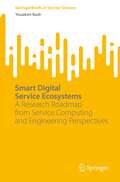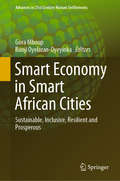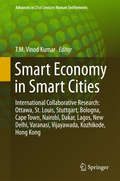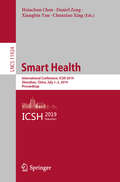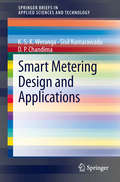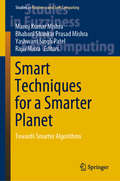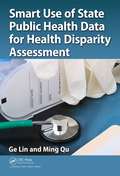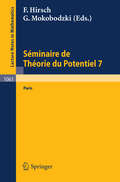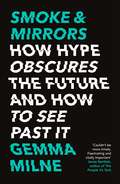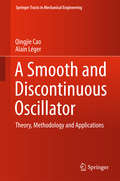- Table View
- List View
Smart Digital Service Ecosystems: A Research Roadmap from Service Computing and Engineering Perspectives (SpringerBriefs in Service Science)
by Youakim BadrThis book provides a holistic overview of the major advances that have been made in the context of Service Science with a focus on IT-enabled services. To address challenges in collaborative, social-centric, ad-hoc, dynamic and open environments, the book studies IT-enabled service systems from two distinct but complementary research perspectives: service engineering and service computing. From a service engineering view, the book shows how to apply a systemic approach to tackle social problems from holistic and multi-disciplinary perspectives by focusing on service systems and developing a service design framework, including socio-technical aspects, the service reference model, data-driven collaboration processes, the incremental design method, requirement propagation, and system adaptability with feedback loops. From a service computing view, the book introduces a service-oriented aided infrastructure to support IT-enabled service systems in ICT-facilitated environments and provide access to tangible and intangible resources in a trustworthy environment. The book offers a valuable companion and comprehensive reference guide for undergraduate and graduate students who want to learn about current concepts for designing and implementing service systems; and for researchers who want to identify future directions in build smart digital service ecosystems, integrating Internet of Things (IoT) and Artificial Intelligence (AI) and cyber-security. The book also appeals to developers who need to implement advanced services and want to capitalize on corresponding business models, customer-driven interaction, and scalable architectures.
Smart Economy in Smart African Cities: Sustainable, Inclusive, Resilient and Prosperous (Advances in 21st Century Human Settlements)
by Gora Mboup Banji Oyelaran-OyeyinkaThis book highlights the use of information and communication technology (ICT) infrastructures in order to develop smart cities and produce smart economies in Africa. It discusses a robust set of concepts, including smart planning, smart infrastructure development, smart economic development, smart environmental sustainability, smart social development, resilience, and smart peace and security in several African cities. By drawing on the accumulated knowledge on various conditions that make cities smart, green, livable and healthy, it helps in the planning, design and management of African urbanization. In turn, it fosters the development of e-commerce, e-education, e-governance, etc. The rapid development of ICT infrastructures facilitates the creation of smart economies in digitally served cities and towns through smart urban planning, smart infrastructures, smart land tenure and smart urban policies. In the long term, this can reduce emissions of CO2, promote the creation of low carbon cities, reduce land degradation and promote biodiversity.
Smart Economy in Smart Cities: International Collaborative Research: Ottawa, St.Louis, Stuttgart, Bologna, Cape Town, Nairobi, Dakar, Lagos, New Delhi, Varanasi, Vijayawada, Kozhikode, Hong Kong (Advances in 21st Century Human Settlements)
by T. M. Vinod KumarThe present book highlights studies that show how smart cities promote urban economic development. The book surveys the state of the art of Smart City Economic Development through a literature survey. The book uses 13 in depth city research case studies in 10 countries such as the North America, Europe, Africa and Asia to explain how a smart economy changes the urban spatial system and vice versa. This book focuses on exploratory city studies in different countries, which investigate how urban spatial systems adapt to the specific needs of smart urban economy. The theory of smart city economic development is not yet entirely understood and applied in metropolitan regional plans. Smart urban economies are largely the result of the influence of ICT applications on all aspects of urban economy, which in turn changes the land-use system. It points out that the dynamics of smart city GDP creation takes ‘different paths,’ which need further empirical study, hypothesis testing and mathematical modelling. Although there are hypotheses on how smart cities generate wealth and social benefits for nations, there are no significant empirical studies available on how they generate urban economic development through urban spatial adaptation. This book with 13 cities research studies is one attempt to fill in the gap in knowledge base.
Smart Health: International Conference, ICSH 2019, Shenzhen, China, July 1–2, 2019, Proceedings (Lecture Notes in Computer Science #11924)
by Hsinchun Chen Daniel Zeng Xiangbin Yan Chunxiao XingThis book constitutes the thoroughly refereed conference proceedings of the International Conference for Smart Health, ICSH 2019, held in Shenzhen, China, in July 2019. The 34 full papers and 1 short papers presented were carefully reviewed and selected from 43 submissions. In this book a lively exchange and collaborations between the growing international smart health research scholars and communities has been introduced, and to advance our understanding about the technical, practical, economic, behavioral, and social issues center on smart health . The selected papers are organized into the following topics: Precision Medicine and Telehealth, Social, Psychosocial and Behavioral Determinants of Health, Data science, Analytics, Clinical and Business Intelligence, Clinical Informatics and Clinician Engagement.
Smart Healthcare and Machine Learning (Advanced Technologies and Societal Change)
by Alejandro C. Frery Mousmi Ajay Chaurasia Prasanalakshmi BalajiThe book explores the convergence of healthcare and cutting-edge technology, making it a captivating subject for readers interested in future research. Smart healthcare with machine learning techniques offers a transformative paradigm that utilizes the power of new technology, data analytics, and interconnected devices to enhance the quality, efficiency, and accessibility of healthcare services. This involves leveraging Internet of Things (IoT) devices, wearable technology, and machine learning algorithms to monitor patient health, predict medical conditions, and offer personalized treatment recommendations. This innovative combination not only enhances diagnostics and treatment but also addresses the research challenges of healthcare access and delivery in an increasingly connected world. By exploring the synergy between smart healthcare and machine learning, the book helps to understand how these technologies can collaborate to revolutionize patient care and healthcare delivery. This book is an outcome with applications of future technologies to overcome the toughest humanitarian challenges from an engineering approach.
Smart Materials: Proceedings of the 1st caesarium, Bonn, November 17–19, 1999
by Karl-Heinz HoffmannWith this proceedings volume a new series of publications is started which will present the results of interdisciplinary research activities in the fields of materials science, coupling of biological and electronic systems and commu nication ergonomy. It will contain the contributions of the participants of the caesarium, a conference caesar will organize annually. The 1 st caesarium was held in Bonn on November 17-19, 1999 concentrating on Smart Materials. With the caesarium the recently founded research center caesar (center of advanced european studies and research) creates a forum for discussion of new developments in its fields of activities. caesar is an international research center, focusing on applied, interdisciplinary research projects in the areas of science and engineering. It was established as an independent foundation under private law as part of the compensatory actions under the Berlin/Bonn law of April 26, 1994 to support the structural change in the region of Bonn, when the German Government moved from Bonn to Berlin. The main donors of caesar are the Federal Republic of Germany and the State of North Rhine-Westphalia. A Board consisting of state and federal leg islators, members from the research community and industry and a Scientific Advisory Council assist caesar in all decisions concerning administration and research.
Smart Medical Imaging for Diagnosis and Treatment Planning
by Nilanjan Dey, Bitan Misra, and Sayan ChakrabortyThis book presents advanced research on smart health technologies, focusing on the innovative transformations in diagnosis and treatment planning using medical imaging and data analysed by data science techniques. It shows how smart health technologies leverage artificial intelligence (AI) and big data analytics to provide more accurate and efficient diagnosis and treatment planning. In search for innovative and novel methods and techniques for health technologies and medical data processing, the book • Discusses applications of Artificial Intelligence, Data Science, Machine Learning, Deep Learning, the Internet of Things, Big Data, Cloud Computing;• Includes use of electronic patient records in healthcare, analysis of big data in medical diagnosis, reliability, and challenges of EPR and EHR in smart healthcare;• Explores evolving techniques for smart healthcare, its application in medical imaging and prediction in the fields of treatment planning;• Provides recent studies in AI-driven healthcare technologies and medical imaging to outline insight into smart healthcare technologies;• Discusses the role of big data in smart healthcare, computing techniques for healthcare for medical diagnosis and treatment planning;• Encompasses the ethical and legal challenges of using smart healthcare and medical data.This book serves as a valuable reference for researchers working on smart health technologies. Researchers of medical imaging, artificial intelligence, and data science along with healthcare domain will find it a great resource as well.
Smart Medical Imaging for Diagnosis and Treatment Planning
This book presents advanced research on smart health technologies, focusing on the innovative transformations in diagnosis and treatment planning using medical imaging and data analysed by data science techniques. It shows how smart health technologies leverage artificial intelligence (AI) and big data analytics to provide more accurate and efficient diagnosis and treatment planning. In search for innovative and novel methods and techniques for health technologies and medical data processing, the book • Discusses applications of Artificial Intelligence, Data Science, Machine Learning, Deep Learning, the Internet of Things, Big Data, Cloud Computing;• Includes use of electronic patient records in healthcare, analysis of big data in medical diagnosis, reliability, and challenges of EPR and EHR in smart healthcare;• Explores evolving techniques for smart healthcare, its application in medical imaging and prediction in the fields of treatment planning;• Provides recent studies in AI-driven healthcare technologies and medical imaging to outline insight into smart healthcare technologies;• Discusses the role of big data in smart healthcare, computing techniques for healthcare for medical diagnosis and treatment planning;• Encompasses the ethical and legal challenges of using smart healthcare and medical data.This book serves as a valuable reference for researchers working on smart health technologies. Researchers of medical imaging, artificial intelligence, and data science along with healthcare domain will find it a great resource as well.
Smart Metering Design and Applications (SpringerBriefs in Applied Sciences and Technology)
by K.S.K Weranga Sisil Kumarawadu D. P. ChandimaTaking into account the present day trends and the requirements, this Brief focuses on smart metering of electricity for next generation energy efficiency and conservation. The contents include discussions on the smart metering concepts and existing technologies and systems as well as design and implementation of smart metering schemes together with detailed examples.
Smart Prisons
by Peiliang SunThis book aims to apply the new generation of information technology to the research and practice of prison management, promote the reform of prison security, fair law enforcement, educational correction and other management modes brought about by strengthening the police with science and technology, deepen the practice of administering prison according to law, and promote the modernization of prison governance system and governance capacity. This book is suitable for the personnel engaged in the management and informatization construction of prisons, drug rehabilitation centers, detention houses, and community correction institutions as professional book and is also suitable as the teaching, training, and reference book of criminal execution, prison management, community correction, judicial information technology, prison information technology, and other majors in the colledge of criminal justice.
Smart Techniques for a Smarter Planet: Towards Smarter Algorithms (Studies in Fuzziness and Soft Computing #374)
by Manoj Kumar Mishra Bhabani Shankar Mishra Yashwant Singh Patel Rajiv MisraThis book is intended to provide a systematic overview of so-called smart techniques, such as nature-inspired algorithms, machine learning and metaheuristics. Despite their ubiquitous presence and widespread application to different scientific problems, such as searching, optimization and /or classification, a systematic study is missing in the current literature. Here, the editors collected a set of chapters on key topics, paying attention to provide an equal balance of theory and practice, and to outline similarities between the different techniques and applications. All in all, the book provides an unified view on the field on intelligent methods, with their current perspective and future challenges.
Smart Use of State Public Health Data for Health Disparity Assessment
by Ge Lin Ming QuHealth services are often fragmented along organizational lines with limited communication among the public health–related programs or organizations, such as mental health, social services, and public health services. This can result in disjointed decision making without necessary data and knowledge, organizational fragmentation, and disparate knowledge development across the full array of public health needs. When new questions or challenges arise that require collaboration, individual public health practitioners (e.g., surveillance specialists and epidemiologists) often do not have the time and energy to spend on them. Smart Use of State Public Health Data for Health Disparity Assessment promotes data integration to aid crosscutting program collaboration. It explains how to maximize the use of various datasets from state health departments for assessing health disparity and for disease prevention. The authors offer practical advice on state public health data use, their strengths and weaknesses, data management insight, and lessons learned. They propose a bottom-up approach for building an integrated public health data warehouse that includes localized public health data. The book is divided into three sections: Section I has seven chapters devoted to knowledge and skill preparations for recognizing disparity issues and integrating and analyzing local public health data. Section II provides a systematic surveillance effort by linking census tract poverty to other health disparity dimensions. Section III provides in-depth studies related to Sections I and II. All data used in the book have been geocoded to the census tract level, making it possible to go more local, even down to the neighborhood level.
Smart Use of State Public Health Data for Health Disparity Assessment
by Ge Lin Ming QuHealth services are often fragmented along organizational lines with limited communication among the public health–related programs or organizations, such as mental health, social services, and public health services. This can result in disjointed decision making without necessary data and knowledge, organizational fragmentation, and disparate knowledge development across the full array of public health needs. When new questions or challenges arise that require collaboration, individual public health practitioners (e.g., surveillance specialists and epidemiologists) often do not have the time and energy to spend on them. Smart Use of State Public Health Data for Health Disparity Assessment promotes data integration to aid crosscutting program collaboration. It explains how to maximize the use of various datasets from state health departments for assessing health disparity and for disease prevention. The authors offer practical advice on state public health data use, their strengths and weaknesses, data management insight, and lessons learned. They propose a bottom-up approach for building an integrated public health data warehouse that includes localized public health data. The book is divided into three sections: Section I has seven chapters devoted to knowledge and skill preparations for recognizing disparity issues and integrating and analyzing local public health data. Section II provides a systematic surveillance effort by linking census tract poverty to other health disparity dimensions. Section III provides in-depth studies related to Sections I and II. All data used in the book have been geocoded to the census tract level, making it possible to go more local, even down to the neighborhood level.
Smart Vehicle Handling - Test und Evaluation in der Fahrzeugtechnik (ATZ/MTZ-Fachbuch)
by Wolf Dieter KäpplerDer Autor vermittelt anhand einer Roadmap Bedeutung und Konzepte von Fahrversuchen als Teil des Entwicklungsprozesses von Kraftfahrzeugen. Er zeigt, dass Fahrversuche nicht nur ein Optimierungs- und Erprobungsprozess in der Fahrzeugentwicklung sind, sondern auch Grundlage valider Simulationen. Unter Sicherheits- und Zuverlässigkeitsaspekten werden die Wechselwirkungen zwischen Fahrern und Fahrzeugen dargestellt. Besonderes Gewicht legt der Autor auf die Qualität moderner experimenteller Versuchsplanung, Messtechnik, Einschätzungen, Messgütekriterien, Standardisierung der Versuchsbedingungen, Analyse und statistische Tests, Reliabilität und Validität sowie Driverless Testing. Er stellt Fahrversuche nicht als technisches Problem dar, sondern als komplexes experimentelles Ereignis, dessen Planung, Durchführung und Auswertung Kompetenzen erfordert, welche über die gängige Ingenieurausbildung hinausgehen. Der Leser erhält fundierte Kenntnisse zu Organisation, Durchführung und Auswertung von Fahrversuchen mit validen Ergebnissen. Außerdem gewinnt er Einblicke in Abläufe und Rollen bei der Entwicklung von Kraftfahrzeugen unter Berücksichtigung der Zwänge von Großserienproduktionen.
SMILE - Übungs- und Lösungsbuch zum Kompaktband Logistik (Schule für Mathematik, Informatik, Logistik und Erfolg)
by Sven WirsingDieses Übungsbuch ergänzt den SMILE-Kompaktband mit einer Vielzahl von Übungsaufgaben und deren Lösungen. Alle im Kompaktband dargestellten Inhalte: Grundlagen, Wareneingangskontrolle, Chargenschnittstelle, Kühlguteinlagerung, GUI-Dialoge und Disposition von LKWs werden mit logistischen und mathematischen Aufgaben sowie Fragestellungen zu Python vertieft. Die Python-Lösungen sind bei Springer downloadbar. Ein besonderes Highlight ist das letzte Kapitel Szenario „Tischtennis-AG“, in dem mittels einer fiktiven Firma, die Tischtennis-AG, die wichtigsten Thematiken zu allen Kapiteln erneut als Aufgaben praxisrelevant dargestellt werden.
Sminaire de Theorie du Potentiel Paris, No. 7 (Lecture Notes in Mathematics #1061)
by M. Brelot F. Hirsch G. Choquet G. Mokobodzki J. DenySmittestopp − A Case Study on Digital Contact Tracing (Simula SpringerBriefs on Computing #11)
This open access book describes Smittestopp, the first Norwegian system for digital contact tracing of Covid-19 infections, which was developed in March and early April 2020. The system was deployed after five weeks of development and was active for a little more than two months, when a drop in infection levels in Norway and privacy concerns led to shutting it down. The intention of this book is twofold. First, it reports on the design choices made in the development phase. Second, as one of the only systems in the world that collected population data into a central database and which was used for an entire population, we can share experience on how the design choices impacted the system's operation. By sharing lessons learned and the challenges faced during the development and deployment of the technology, we hope that this book can be a valuable guide for experts from different domains, such as big data collection and analysis, application development, and deployment in a national population, as well as digital tracing.
Smoke & Mirrors: How Hype Obscures the Future and How to See Past It
by Gemma Milne'Stop following the news until you've read Gemma Milne's persuasive analysis of the hype and bullshit that distort our understanding of emerging science. As she shows, the starting point to grasping the genuine opportunities of AI, life sciences and climate tech is a healthy dose of critical thinking'David Rowan, founding editor of WIRED UK and author of Non-Bullshit Innovation: Radical Ideas from the World's Smartest Minds'Couldn't be more timely. Fascinating and vitally important' Jamie Bartlett, author of The People Vs Tech 'A much-needed blast of fresh air! Gemma Milne expertly shows us how to separate the truth from the hype surrounding the emerging techs of today, and those of the near-tomorrow.' Lewis Dartnell, author of Origins: How the Earth Made Us'I loved this book! This is exactly the sort of sceptical, cut-through-the crap-but-still-excited-about-what's-emerging book around tech innovation that's sorely needed, yet is so hard to find . . . essential reading for anyone who's serious about how real-world advances might be effectively harnessed to build a better future.' Dr Andrew Maynard, scientist and author of Films from the Future and Future Rising'Smoke & Mirrors is a vital contribution in a world where technological progress promises so much, but too often disappoints. If, like me, you believe that advances in science and technology are our best hope for solving the grand challenges of our times, this book is the indispensable guide to avoiding the mirages and the charlatans along the way.' Matt Clifford, co-founder and CEO of Entrepreneur First'A refreshingly grown-up, clear-headed look at the interaction between science, technology and the media - readable without being dumbed down, acknowledging complexities without being heavy.' Tom Chivers, author of The AI Does Not Hate You'In this book, we see technological hype for what it is: not mere exuberance, but a form of attention-seeking. As some technological hucksters stake claims on our future and try to foreclose alternatives, we need strong defences. Gemma Milne offers a spotter's guide to hype, using science to bring speculation down to earth. People inside and outside the world of technological innovation need this book.' Jack Stilgoe, author of Who's Driving Innovation?'ROBOTS WILL STEAL YOUR JOB!''AI WILL REVOLUTIONISE FARMING!''GENETIC EDITING WILL CURE CANCER!'Bombastic headlines about science and technology are nothing new. To cut through the constant stream of information and misinformation on social media, or grab the attention of investors, or convince governments to take notice, strident headlines or bold claims seem necessary to give complex, nuanced information some wow factor.But hype has a dark side, too.It can mislead. It can distract. It can blinker us from seeing what is actually going on.From AI, quantum computing and brain implants, to cancer drugs, future foods and fusion energy, science and technology journalist Gemma Milne reveals hype to be responsible for fundamentally misdirecting or even derailing crucial progress.Hype can be combated and discounted, though, if you're able to see exactly where, how and why it is being deployed.This book is your guide to doing just that.
A Smooth and Discontinuous Oscillator: Theory, Methodology and Applications (Springer Tracts in Mechanical Engineering)
by Qingjie Cao Alain LégerThis is the first book to introduce the irrational elliptic function series, providing a theoretical treatment for the smooth and discontinuous system and opening a new branch of applied mathematics. The discovery of the smooth and discontinuous (SD) oscillator and the SD attractors discussed in this book represents a further milestone in nonlinear dynamics, following on the discovery of the Ueda attractor in 1961 and Lorenz attractor in 1963.This particular system bears significant similarities to the Duffing oscillator, exhibiting the standard dynamics governed by the hyperbolic structure associated with the stationary state of the double well. However, there is a substantial departure in nonlinear dynamics from standard dynamics at the discontinuous stage. The constructed irrational elliptic function series, which offers a way to directly approach the nature dynamics analytically for both smooth and discontinuous behaviours including the unperturbed periodic motions and the perturbed chaotic attractors without any truncation, is of particular interest. Readers will also gain a deeper understanding of the actual nonlinear phenomena by means of a simple mechanical model: the theory, methodology, and the applications in various interlinked disciplines of sciences and engineering. This book offers a valuable resource for researchers, professionals and postgraduate students in mechanical engineering, non-linear dynamics, and related areas, such as nonlinear modelling in various fields of mathematics, physics and the engineering sciences.
Smooth Bézier Surfaces over Unstructured Quadrilateral Meshes (Lecture Notes of the Unione Matematica Italiana #22)
by Michel Bercovier Tanya MatskewichUsing an elegant mixture of geometry, graph theory and linear analysis, this monograph completely solves a problem lying at the interface of Isogeometric Analysis (IgA) and Finite Element Methods (FEM). The recent explosion of IgA, strongly tying Computer Aided Geometry Design to Analysis, does not easily apply to the rich variety of complex shapes that engineers have to design and analyse. Therefore new developments have studied the extension of IgA to unstructured unions of meshes, similar to those one can find in FEM. The following problem arises: given an unstructured planar quadrilateral mesh, construct a C1-surface, by piecewise Bézier or B-Spline patches defined over this mesh. This problem is solved for C1-surfaces defined over plane bilinear Bézier patches, the corresponding results for B-Splines then being simple consequences. The method can be extended to higher-order quadrilaterals and even to three dimensions, and the most recent developments in this direction are also mentioned here.
Smooth Ergodic Theory for Endomorphisms (Lecture Notes in Mathematics #1978)
by Min Qian Jian-Sheng Xie Shu ZhuSmooth Ergodic Theory of Random Dynamical Systems (Lecture Notes in Mathematics #1606)
by Pei-Dong Liu Min QianThis book studies ergodic-theoretic aspects of random dynam- ical systems, i.e. of deterministic systems with noise. It aims to present a systematic treatment of a series of recent results concerning invariant measures, entropy and Lyapunov exponents of such systems, and can be viewed as an update of Kifer's book. An entropy formula of Pesin's type occupies the central part. The introduction of relation numbers (ch.2) is original and most methods involved in the book are canonical in dynamical systems or measure theory. The book is intended for people interested in noise-perturbed dynam- ical systems, and can pave the way to further study of the subject. Reasonable knowledge of differential geometry, measure theory, ergodic theory, dynamical systems and preferably random processes is assumed.
Smooth Four-Manifolds and Complex Surfaces (Ergebnisse der Mathematik und ihrer Grenzgebiete. 3. Folge / A Series of Modern Surveys in Mathematics #27)
by Robert Friedman John W. MorganIn 1961 Smale established the generalized Poincare Conjecture in dimensions greater than or equal to 5 [129] and proceeded to prove the h-cobordism theorem [130]. This result inaugurated a major effort to classify all possible smooth and topological structures on manifolds of dimension at least 5. By the mid 1970's the main outlines of this theory were complete, and explicit answers (especially concerning simply connected manifolds) as well as general qualitative results had been obtained. As an example of such a qualitative result, a closed, simply connected manifold of dimension 2: 5 is determined up to finitely many diffeomorphism possibilities by its homotopy type and its Pontrjagin classes. There are similar results for self-diffeomorphisms, which, at least in the simply connected case, say that the group of self-diffeomorphisms of a closed manifold M of dimension at least 5 is commensurate with an arithmetic subgroup of the linear algebraic group of all automorphisms of its so-called rational minimal model which preserve the Pontrjagin classes [131]. Once the high dimensional theory was in good shape, attention shifted to the remaining, and seemingly exceptional, dimensions 3 and 4. The theory behind the results for manifolds of dimension at least 5 does not carryover to manifolds of these low dimensions, essentially because there is no longer enough room to maneuver. Thus new ideas are necessary to study manifolds of these "low" dimensions.
Smooth Functions and Maps (Moscow Lectures #7)
by Boris M. Makarov Anatolii N. PodkorytovThe book contains a consistent and sufficiently comprehensive theory of smooth functions and maps insofar as it is connected with differential calculus. The scope of notions includes, among others, Lagrange inequality, Taylor’s formula, finding absolute and relative extrema, theorems on smoothness of the inverse map and on conditions of local invertibility, implicit function theorem, dependence and independence of functions, classification of smooth functions up to diffeomorphism. The concluding chapter deals with a more specific issue of critical values of smooth mappings. In several chapters, a relatively new technical approach is used that allows the authors to clarify and simplify some of the technically difficult proofs while maintaining full integrity. Besides, the book includes complete proofs of some important results which until now have only been published in scholarly literature or scientific journals (remainder estimates of Taylor’s formula in a nonconvex area (Chapter I, §8), Whitney's extension theorem for smooth function (Chapter I, §11) and some of its corollaries, global diffeomorphism theorem (Chapter II, §5), results on sets of critical values of smooth mappings and the related Whitney example (Chapter IV). The text features multiple examples illustrating the results obtained and demonstrating their accuracy. Moreover, the book contains over 150 problems and 19 illustrations. Perusal of the book equips the reader to further explore any literature basing upon multivariable calculus.
Smooth Manifolds (Compact Textbooks in Mathematics)
by Claudio GorodskiThis concise and practical textbook presents the essence of the theory on smooth manifolds. A key concept in mathematics, smooth manifolds are ubiquitous: They appear as Riemannian manifolds in differential geometry; as space-times in general relativity; as phase spaces and energy levels in mechanics; as domains of definition of ODEs in dynamical systems; as Lie groups in algebra and geometry; and in many other areas. The book first presents the language of smooth manifolds, culminating with the Frobenius theorem, before discussing the language of tensors (which includes a presentation of the exterior derivative of differential forms). It then covers Lie groups and Lie algebras, briefly addressing homogeneous manifolds. Integration on manifolds, explanations of Stokes’ theorem and de Rham cohomology, and rudiments of differential topology complete this work. It also includes exercises throughout the text to help readers grasp the theory, as well as more advanced problems for challenge-oriented minds at the end of each chapter. Conceived for a one-semester course on Differentiable Manifolds and Lie Groups, which is offered by many graduate programs worldwide, it is a valuable resource for students and lecturers alike.
